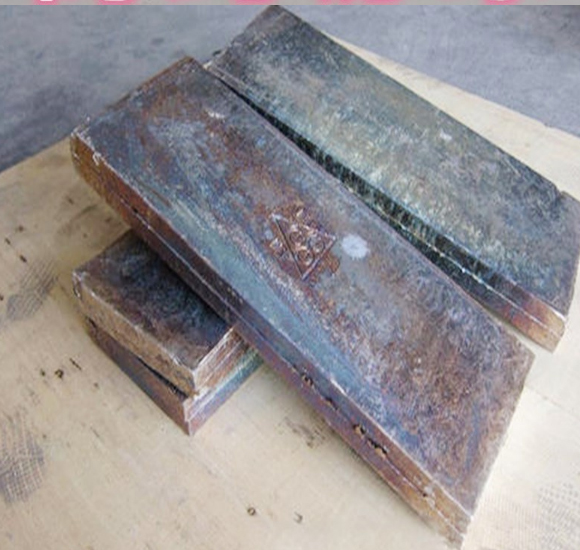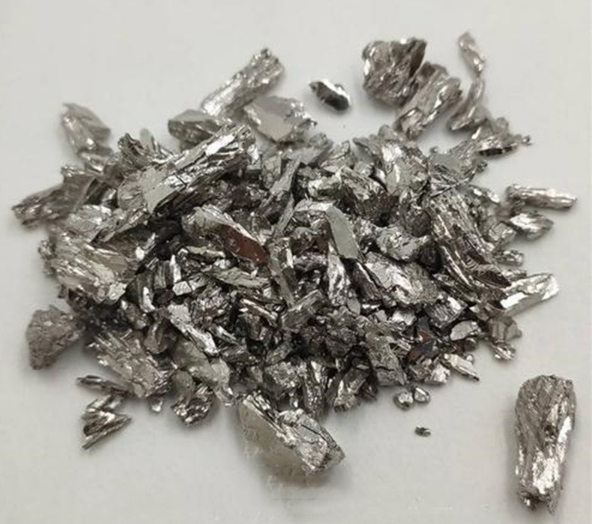99.99% Pure Bismuth Metal Ingot
Bismuth, 99.99% Pure Bismuth Metal Ingot Chunk Bismuth for the
production of crystals / fishing lures, diamagnetic
Bismuth has many interesting properties. It has a relatively low melting
point of around 520 degrees Fahrenheit, which makes it useful for
alloying with other metals
The thermal conductivity of bismuth is very low, expands and cools with
an extremely high diamagnetic value
Mainly used in the manufacture of bismuth alloys, medicines, chemical
reagents, base melting point alloys, nuclear reactors and so on
Also widely used in the semiconductor, superconductor, flame retardant,
pigment, cosmetic, electronic ceramic lamp sector
Bismuth is used to grow beautiful iridescent funnel crystals that are
used in jewelry and art
Mainly used in the manufacture of bismuth alloys, medicines, chemical
reagents, base melting point alloys, nuclear reactors and so on. Also
widely used in the semiconductor, superconductor, flame retardant,
pigment, cosmetic, electronic ceramic lamp sector. Bismuth is used to
grow beautiful iridescent funnel crystals that are used in jewelry and
art. Bismuth is a non-toxic and environmentally friendly substitute for
lead.
Descriptions:
Bismuth has many interesting properties. It has a relatively low melting
point of around 520 degrees Fahrenheit, which makes it useful for alloys
with other metals. The thermal conductivity of bismuth is very low,
expands and cools down with an extremely high diamagnetic value.
Properties:
Bismuth has many interesting properties. It has a relatively low melting
point of around 520 degrees Fahrenheit, which makes it useful for
alloying with other metals.
The thermal conductivity of bismuth is very low, expands and cools with
an extremely high diamagnetic value.
Mainly used in the manufacture of bismuth alloys, medicines, chemical
reagents, base melting point alloys, nuclear reactors and so on. Also
widely used in the semiconductor, superconductor, flame retardant,
pigment, cosmetic, electronic ceramic lamp sector. Bismuth is used to
grow beautiful iridescent funnel crystals that are used in jewelry and
art. Bismuth is a non-toxic and environmentally friendly substitute for
lead.
Specifications:
Product name: bismuth bar
Bismuth content: ≥99.99 (%)
Density: 9.8 / cm^3
Melting point: 271
Bismuth expands when it solidifies. Due to this property, bismuth alloys
are particularly suitable for the production of sharp castings that can
be damaged by high temperatures. Bismuth forms low-melting alloys with
other metals such as tin, cadmium, etc., which are often used for safety
devices in fire detection and extinguishing systems. Bismuth is also
used for the production of forgeable iron and is used as a catalyst for
the production of acrylic fibers.
High purity (99.9999%) bismuth (Bi) sputtering target
When bismuth is heated in air, it burns with a blue flame and forms
yellow oxide vapors. The metal is also used as a thermocouple material
and has been used as a carrier for 235 U or 233 U fuel in nuclear
reactors. Its soluble salts are characterized by the fact that they form
insoluble basic salts with the addition of water, a property that is
sometimes used in detection. Bismuth oxychloride is widely used in
cosmetics. Elemental or metallic forms of bismuth include pellets, rods,
wires and granules for evaporation source material purposes. Bismuth
oxide is available in the form of powders and dense pellets for
applications such as optical coatings and thin film applications. Oxides
tend to be insoluble. Bismuth fluorides are another insoluble form for
applications where oxygen is undesirable, such as metallurgy, chemical
and physical vapor deposition, and in some optical coatings. Bismuth is
also available in soluble forms including chlorides, nitrates and
acetates. These compounds are made as solutions for certain
stoichiometries..
.


Bismuth, 99.99% Pure Bismuth Metal Ingot Chunk Bismuth for the
production of crystals / fishing lures, diamagnetic
Bismuth has many interesting properties. It has a relatively low melting
point of around 520 degrees Fahrenheit, which makes it useful for
alloying with other metals
The thermal conductivity of bismuth is very low, expands and cools with
an extremely high diamagnetic value
Mainly used in the manufacture of bismuth alloys, medicines, chemical
reagents, base melting point alloys, nuclear reactors and so on
Also widely used in the semiconductor, superconductor, flame retardant,
pigment, cosmetic, electronic ceramic lamp sector
Bismuth is used to grow beautiful iridescent funnel crystals that are
used in jewelry and art
Mainly used in the manufacture of bismuth alloys, medicines, chemical
reagents, base melting point alloys, nuclear reactors and so on. Also
widely used in the semiconductor, superconductor, flame retardant,
pigment, cosmetic, electronic ceramic lamp sector. Bismuth is used to
grow beautiful iridescent funnel crystals that are used in jewelry and
art. Bismuth is a non-toxic and environmentally friendly substitute for
lead.
Descriptions:
Bismuth has many interesting properties. It has a relatively low melting
point of around 520 degrees Fahrenheit, which makes it useful for alloys
with other metals. The thermal conductivity of bismuth is very low,
expands and cools down with an extremely high diamagnetic value.
Properties:
Bismuth has many interesting properties. It has a relatively low melting
point of around 520 degrees Fahrenheit, which makes it useful for
alloying with other metals.
The thermal conductivity of bismuth is very low, expands and cools with
an extremely high diamagnetic value.
Mainly used in the manufacture of bismuth alloys, medicines, chemical
reagents, base melting point alloys, nuclear reactors and so on. Also
widely used in the semiconductor, superconductor, flame retardant,
pigment, cosmetic, electronic ceramic lamp sector. Bismuth is used to
grow beautiful iridescent funnel crystals that are used in jewelry and
art. Bismuth is a non-toxic and environmentally friendly substitute for
lead.
Specifications:
Product name: bismuth bar
Bismuth content: ≥99.99 (%)
Density: 9.8 / cm^3
Melting point: 271
Bismuth expands when it solidifies. Due to this property, bismuth alloys
are particularly suitable for the production of sharp castings that can
be damaged by high temperatures. Bismuth forms low-melting alloys with
other metals such as tin, cadmium, etc., which are often used for safety
devices in fire detection and extinguishing systems. Bismuth is also
used for the production of forgeable iron and is used as a catalyst for
the production of acrylic fibers.
High purity (99.9999%) bismuth (Bi) sputtering target
When bismuth is heated in air, it burns with a blue flame and forms
yellow oxide vapors. The metal is also used as a thermocouple material
and has been used as a carrier for 235 U or 233 U fuel in nuclear
reactors. Its soluble salts are characterized by the fact that they form
insoluble basic salts with the addition of water, a property that is
sometimes used in detection. Bismuth oxychloride is widely used in
cosmetics. Elemental or metallic forms of bismuth include pellets, rods,
wires and granules for evaporation source material purposes. Bismuth
oxide is available in the form of powders and dense pellets for
applications such as optical coatings and thin film applications. Oxides
tend to be insoluble. Bismuth fluorides are another insoluble form for
applications where oxygen is undesirable, such as metallurgy, chemical
and physical vapor deposition, and in some optical coatings. Bismuth is
also available in soluble forms including chlorides, nitrates and
acetates. These compounds are made as solutions for certain
stoichiometries..
.


